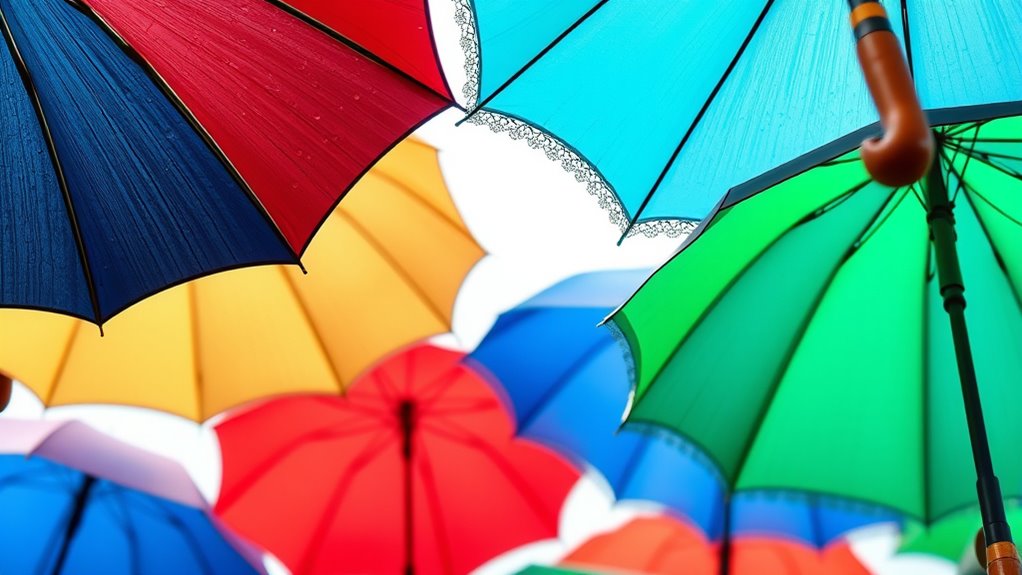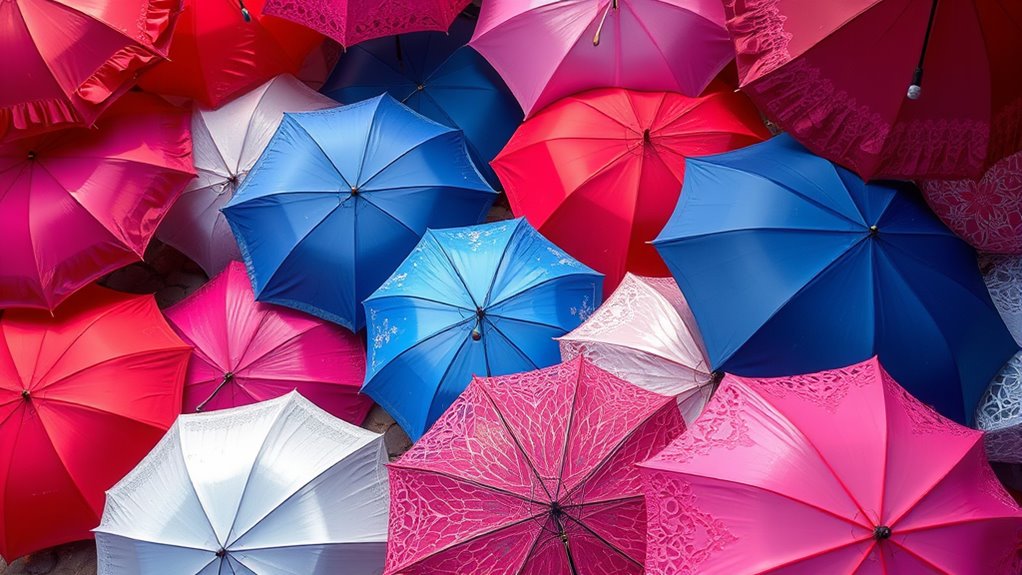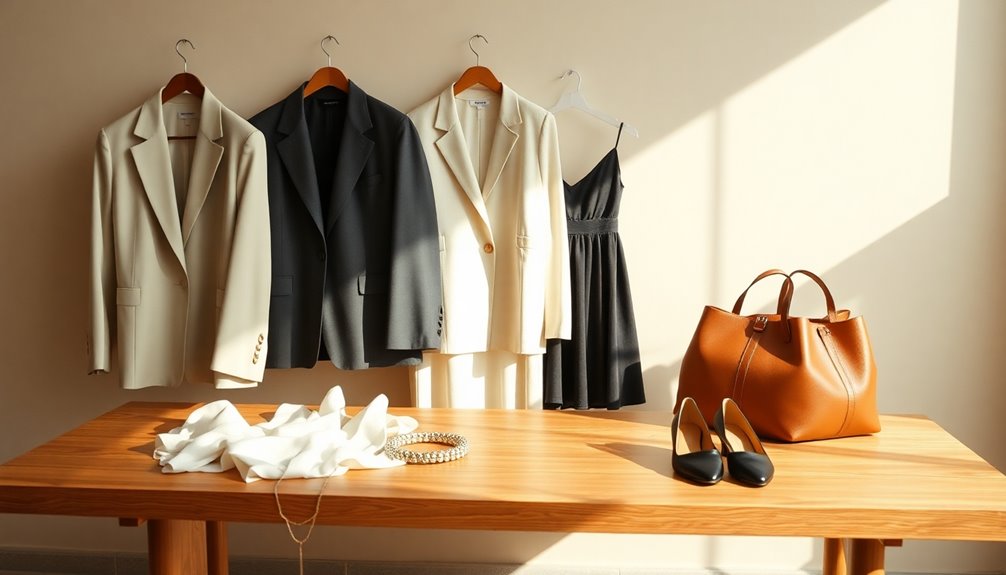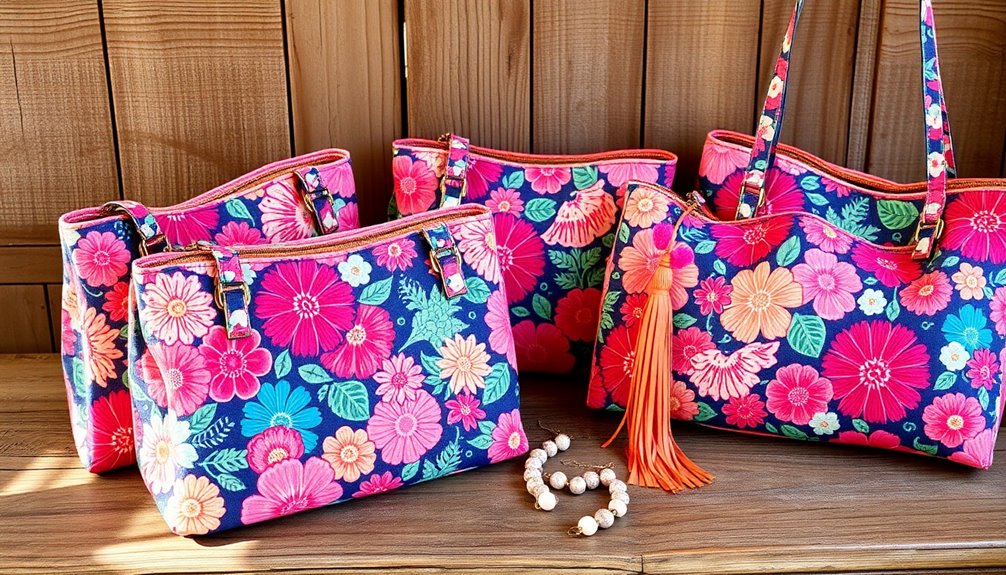There are various types of umbrellas, such as compact, golf, bubble, and traditional silk umbrellas, each suited for different styles and needs. To care for your umbrella, always open it gently, dry it thoroughly after use, and store it in a cool, dry place. Regular maintenance like cleaning the canopy and checking the frame helps it last longer. Want to discover more about choosing the right umbrella and keeping it in top shape?
Key Takeaways
- Understand different umbrella types, such as compact, golf, and traditional Asian silk umbrellas, for appropriate use and care.
- Regularly dry umbrellas thoroughly to prevent rust and mold, especially after exposure to rain.
- Use protective cases or covers when not in use to avoid damage and prolong lifespan.
- Handle frames gently to prevent bending or breaking, particularly with delicate or ornate designs.
- Store umbrellas in a dry, cool place, and occasionally check for rust or fabric wear to maintain their appearance and function.

Umbrellas are essential accessories that protect you from rain and sun, and choosing the right type can make a big difference in your daily comfort. To understand why, it helps to look at their historical evolution and cultural significance. Umbrellas have been around for thousands of years, with origins dating back to ancient civilizations like Egypt, China, and Greece. Initially, they were used primarily as sunshades rather than rain protectors, symbolizing status and power. Over time, their design and purpose evolved, especially during the 18th and 19th centuries, when technological advancements allowed for more durable and portable models. Today, umbrellas blend functionality with fashion, but their rich history remains embedded in their design and use.
Umbrellas have evolved from ancient symbols of status to essential, stylish accessories blending history, culture, and practicality.
Throughout history, umbrellas have held different cultural meanings. In some societies, they signified wealth or authority, often reserved for royalty or high-ranking officials. For instance, in ancient Egypt, umbrellas made from palm leaves or fabric signified nobility and were used in processions. In China, umbrellas became symbols of protection and prosperity, often featured in art and religious ceremonies. Western cultures also adopted umbrellas as fashion statements, especially in the Victorian era, when they were crafted with ornate fabrics and intricate designs. The cultural significance attached to umbrellas has shifted over the centuries from symbols of social status to practical items accessible to many. Still, in some traditions, they carry symbolic weight—representing protection, hope, or even spiritual guardianship. Recognizing the cultural evolution of umbrellas can help you appreciate how they serve as more than just weather protection.
When selecting the right umbrella, understanding its historical and cultural background helps you appreciate its purpose beyond mere utility. For example, a traditional Asian silk umbrella might serve as a cultural artifact, while a modern compact umbrella prioritizes portability and convenience. Recognizing these differences can influence your choice based on style, durability, and occasion. Whether you opt for a classic design with historical roots or a contemporary, tech-enhanced model, knowing the cultural significance can deepen your connection to this everyday item.
In essence, your choice of umbrella isn’t just about weather protection; it’s also about embracing a piece of history and culture. By understanding how umbrellas have evolved and what they symbolize across different societies, you can select a model that resonates with your personal style or appreciation for tradition. This awareness elevates a simple rain or sun protector into a meaningful accessory, blending practicality with cultural appreciation. So, next time you open your umbrella, remember that you’re holding a device that has traveled through history and holds cultural significance across the world, making your daily routine a little more meaningful.
Frequently Asked Questions
How Do I Prevent My Umbrella From Rusting?
To prevent your umbrella from rusting, regularly dry it thoroughly after use, especially if it’s made of metal, to avoid moisture buildup. Use rust prevention spray on the metal parts and store it in a dry, cool place. Check the umbrella material for any signs of rust and address them early. Keeping your umbrella dry and applying protective treatments helps maintain its condition and extends its lifespan.
Can I Repair a Broken Umbrella Handle Myself?
Yes, you can do umbrella handle repair yourself with DIY handle fixing. First, assess the damage to determine if the handle is loose or broken. Use strong adhesive or epoxy for minor cracks or detachments. For more extensive damage, you might need to replace the handle entirely, which involves removing the old handle and attaching a new one with suitable glue or screws. With patience, you can restore your umbrella’s handle easily.
Are There Eco-Friendly Umbrella Options Available?
Yes, eco-friendly umbrella options are available. You can choose umbrellas made from recyclable materials, which help reduce waste. Look for brands that prioritize sustainable manufacturing processes, ensuring minimal environmental impact. Some umbrellas use biodegradable handles or fabrics made from recycled plastics. By selecting these options, you support environmentally conscious practices and contribute to reducing your carbon footprint while staying protected from the rain.
How Do I Choose the Right Umbrella for Windy Conditions?
Choosing the right umbrella for windy conditions is like picking a sturdy sailboat for rough seas. Look for wind-resistant features like vented canopies and flexible ribs that bend without breaking. Compact travel umbrellas can be great, but make certain they’re built with durable materials and reinforced joints. Test their wind resistance before buying, so you’re ready when gusts pick up. With the right choice, you’ll stay dry even in a storm.
What Is the Lifespan of a Typical Umbrella?
A typical umbrella lasts about 1 to 5 years, depending on umbrella durability and material longevity. If you take good care of it, avoiding harsh weather and storing it properly, it can stay in good condition longer. Regularly check for rust or fabric tears, and dry it thoroughly after use. Choosing a sturdy frame and high-quality fabric also helps extend its lifespan, ensuring you get the most out of your umbrella.
Conclusion
When you think about umbrellas, it’s funny how a simple tool can turn rainy days into manageable moments. As you choose the right type and care for it properly, you’ll find that your umbrella becomes more than just a shield—it’s a reliable companion in unexpected weather. Sometimes, the smallest details, like knowing how to maintain it, make all the difference. So next time rain surprises you, remember, your well-cared-for umbrella is ready to stand by your side.










